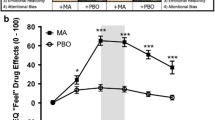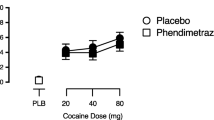Abstract
In nine experienced users of cocaine, we examined the urge to use cocaine or other drugs following a 40 mg dose of intravenous (IV) cocaine with and without oral pretreatment with 2.5 mg bromocriptine. The urge to use cocaine was assessed with a questionnaire constructed to assess both “wanting” and “craving” for cocaine or other drugs. Fifteen minutes after the administration of cocaine (but not after placebo), subjects' ratings for both drug “wanting” and drug “craving” were significantly increased. Our results provide a laboratory demonstration of cocaine-induced increases in the urge to use drugs in humans. The findings, stressing the role of internal stimuli associated with drug administration, suggest the possibility of distinguishing among related, but perhaps distinct, components of the fluctuating levels of motivation to reuse drugs.
Similar content being viewed by others
References
Baker TB, Cannon DS (1979) Taste aversion therapy with alcoholics: techniques and evidence of a conditioned response. Behav Res Ther 17:229–242
Cannon DS, Baker TB (1981) Emetic and electric shock alcohol aversion therapy: assessment of conditioning. J Consult Clin Psychol 49:20–33
Childress AR, McLellan AT, O'Brien CP (1984) Assessment and extinction of conditioned opiate withdrawal-like responses in an integrated treatment for opiate dependence. In: Harris LS (ed) Problems of drug dependence. National Institute on Drug Abuse Research Monograph 55, DHEW Pub No (ADM) 851393. Washington, DC: Supt of Docs, US Government Printing Office, pp 202–210
Childress AR, McLellan AT, O'Brien CP (1985) Nature and incidence of conditioned responses in a methadone maintenance population: a comparison of laboratory, clinic and naturalistic settings. In: Harris LS (ed) Problems of drug dependence. National Institute on Drug Abuse Research Monograph 67, DHEW Pub No (ADM) 86-1448. Washington DC: Supt of Docs, US Government Printing Office, pp 366–372
Childress AR, McLellan AT, O'Brien CP (1986a) Conditioned responses in a methadone population. J Subst Abuse Treat 3:173–179
Childress AR, McLellan AT, Natale M, O'Brien CP (1986b) Mood States can elicit conditioned withdrawal and craving in opiate abuse patients. In: Harris LS (ed) Problems of drug dependence. National Institute on Drug Abuse Research Monograph 76, DHEW Pub No (ADM) 87-1508. Washington DC: Supt of Docs, US Government Printing Office, pp 137–144
Childress AR, McLellan AT, Ehrman R, O'Brien CP (1986c) Extinction of conditioned responses in abstinent cocaine or opioid users. In: Harris LS (ed) Problems of drug dependence. National Institute on Drug Abuse Research Monograph 76, DHEW Pub No (ADM) 87-1508. Washington DC: Supt of Docs, US Government Printing Office, pp 189–195
Dackis CA, Gold MS (1985a) Bromocriptine as a treatment for cocaine abuse. Lancet I:1151–1152
Dackis CA, Gold MS (1985b) Pharmacological approaches to cocaine addiction. J Subst Abuse Treat 2:139–145
Dackis CA, Gold MS (1985c) New concepts in cocaine addiction: the dopamine depletion hypothesis. Neurosci Biobehav Rev 9:469–477
Dackis CA, Gold MS (1987) The physiology of cocaine craving and crashing. Arch Gen Psychiatry 44:298–299
Dackis CA, Gold MS, Estroff TW, Sweeney DR (1984) Hyperprolactinemia in cocaine abuse. Soc Neurosci Abstr 10:1099
Davis WM, Smith SG (1976) Role of conditioned reinforcers in the initiation, maintenance, and extinction of drug-seeking behavior. Pavlov J Bio Sci 11:222–236
de la Garza R, Johanson CE (1982) Effects of haloperidol and physostigmine on self-administration of local anesthetics. Pharmacol Biochem Behav 17:1295–1299
de Wit H, Stewart J (1981) Reinstatement of cocaine-reinforced responding in the rat. Psychopharmacology 75:134–143
de Wit H, Stewart J (1983) Drug reinstatement of heroin reinforced responding in the rat. Psychopharmacology 79:29–31
de Wit H, Wise RA (1977) Blockade of cocaine reinforcement with the dopamine receptor blocker pimozide but not with the noradrenergic blockers phentolamine or phenoxybenzamine. Can J Psychol 31:195–203
Dorus W, Senay E (1980) Depression, demographic factors and drug abuse. Am J Psychiatry 137:24–36
Fischman MW, Schuster CR (1982) Cocaine self-administration in humans. Fed Proc 41:241–246
Gawin FH, Kleber HD (1986) Abstinence symptomatology and psychiatric diagnosis in cocaine abusers: Clinical observations. Arch Gen Psychiatry 43:107–113
Gawin FH, Kleber HD (1987) The physiology of cocaine craving and crashing. Arch Gen Psychiatry 44:299–300
Gerber GJ, Stretch R (1975) Drug-induced reinstatement of extinguished self-administration behavior in monkeys. Pharm Biochem Behav 3:1055–1061
Gold MS, Dackis CA (1984) New insights and treatments: opiate withdrawal and cocaine addiction. Clin Ther 7:6–21
Ho BT, Taylor DL, Estevez VS (1977) Behavioral effects of cocaine: Metabolic and neurochemical approach. In: Ellinwood EH, Kilbey MM (eds) Cocaine and other stimulants. Plenum Press, New York, pp 229–239
Kaplan RF, Cooney NL, Baker LH, Gillespie RA, Meyer RD, Pomerlau OF (1985) Reactivity to alcohol-related cues: physiological and subjective responses in alcoholics and non-problem drinkers. J Stud Alcohol 46:267–272
Karoly AJ, Winger C, Ikomi F, Woods JH (1978) The reinforcing property of ethanol in the rhesus monkey, II. Some variables related to the maintenance of intravenous ethanol-reinforced responding. Psychopharmacology 58:19–25
Keppel C (1973) Design and Analysis: a researcher's handbook. Prentice Hall, Englewood Cliffs, New Jersey
Kleber HC, Gawin FH (1987) The physiology of cocaine craving and “crashing”. Arch Gen Psychiatry 44:299–300
Ludwig AM, Stark LH (1974) Alcohol craving. Subjective and situational aspects. Q J Stud Alcohol 35:899–905
Ludwig AM, Wikler A (1974) Craving and relapse to drink. Q J Stud Alcohol 35:108–130
Ludwig AM, Wikler A, Stark LH (1974) The first drink. Psychobiological aspects of craving. Arch Gen Psychiatry 30:539–547
McAuliffe WE, Ch'ien JMN (1986) Recovery training and self help: a relapse-prevention program for treated opiate addicts. J Subst Abuse Treat 3:9–20
McCaul ME, Turkkan JS, Stitzer ML (1986) Psychophysiological effects of alcohol-related stimuli: In: Harris LS (ed) Problems of drug dependence. National Institute on Drug Abuse Research Monograph 76, DHEW Pub No (ADM) 87-1508. Washington DC: Supt of Docs, US Government Printing Office, pp 131–136
McLellan AT, Childress AR, Ehrman R, O'Brien CP (1986) Extinguishing conditioned responses during opiate dependence treatment turning laboratory findings into clinical procedures. J Subst Abuse Treat 3:27–32
Mello NK (1972) Behavioral studies of alcoholism. In: Kissin B, Begleiter H (eds) Biology of alcoholism, vol II, Plenum Press, New York, pp 219–231
Memo MS, Pradhan S, Hanbauer I (1981) Cocaine-induced super-sensitivity of striatal dopamine receptors: role of endogenous calmodulin. Neuropharmacology 20:1145–1150
Meyer RE, Mirin SM (1979) The heroin stimulus: implication for a theory of addiction. Plenum Press, New York
O'Brien CP (1975) Experimental analysis of conditioning factors in human narcotic addiction. Pharmacol Rev 27:533–543
O'Brien CP, Testa T, O'Brien TJ, Brady JP, Wells B (1977) Conditioned narcotic withdrawal in humans. Science 195:1000–1002
O'Brien CP, Greenstein R, Ternes J, McLellan AT, Grabowski J (1980) Unreinforced self-injections: Effects on rituals and outcome in heroin addicts. In: Harris LS (ed) Problems of drug dependence. National Institute on Drug Abuse Research Monograph 27, DHEW Pub No (ADM) 80:901. Washington DC: Supt of Docs, US Government Printing Office, pp 275–281
Rounsaville BJ, Weissmann MM, Kleber HD, Wilber C (1982) The heterogenity of psychiatric diagnosis in treated opiate addicts. Arch Gen Psychiatry 39:161–166
Roy SN, Bhattacharya AK, Pradhan S, Pradhan SN (1978) Behavioral and neurochemical effects of repeated administration of cocaine in rats. Neuropharmacology 17:559–564
Seiden L (1984) Neurochemical toxic effects of psychomotor stimulants. Presented at the 23rd Annual Meeting of the American College of Neuropharmacology
Sherer MA (1987) Intravenous cocaine — psychiatric effects, biological mechanisms. Presented at the annual meeting of the Society of Biological Psychiatry
Sherer MA, Kumor KM, Jaffe JH (1988) Partial reduction of the subjective effects of cocaine by haloperidol (in press)
Sideroff S, Jarvik ME (1980) Conditioned responses to a videotape showing heroin-related stimuli. Int J Addict 15(4):529–536
Taylor DL, Ho BT (1977) Neurochemical effects of cocaine following acute and repeated injection. J Neurosci Res 3:95–101
Taylor DL, Ho BT, Fagan DJ (1979) Increased dopamine receptor binding in rat brain by separated cocaine injections. Commun Psychopharmacol 3:137–142
Teasdale J (1973) Conditioned abstinence in narcotic addicts. Int J Addict 8:273–292
Ternes JW, O'Brien CP, Grabowski J, Wellerstein H, Jordan-Hayes J (1980) Conditioned drug responses to naturalistic stimuli. In: Harris LS (ed) Problems of drug dependence. National Institute on Drug Abuse Research Monograph 27, DHEW Pub No (ADM) 80-901. Washington DC: Supt of Docs, US Government Printing Office, pp 282–288
Wikler A (1965) Conditioning factors in opiate addiction and relapse. In: Wilner DI, Kassenbaum GG (eds) Narcotics. McGraw-Hill, New York, pp 85–100
Woody GD, O'Brien CP, Rickels K (1975) Depression and anxiety in heroin adicts. Am J Psychiatry 32:411–414
Woolverton WL, Goldberg LI, Ginos JZ (1984) Intravenous self-administration of dopamine agonists by rhesus monkeys. J Pharmacol Exp Ther 230:678–683
Author information
Authors and Affiliations
Rights and permissions
About this article
Cite this article
Jaffe, J.H., Cascella, N.G., Kumor, K.M. et al. Cocaine-induced cocaine craving. Psychopharmacology 97, 59–64 (1989). https://doi.org/10.1007/BF00443414
Received:
Accepted:
Issue Date:
DOI: https://doi.org/10.1007/BF00443414




